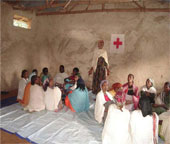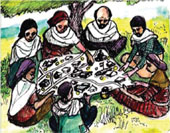Participatory Hygiene and Sanitation Transformation (PHAST)
PHAST is a widely used community approach to hygiene promotion. It uses participatory techniques to promote good hygiene behaviours, sanitation improvements and community management of water supply and sanitation facilities. It is derived from a community appraisal method of health practice that, in the process, empowers community members (participants) to be able to identify their community problems. Community appraisal is a process for analysing the existing community health problems by mapping water and sanitation, and identifying good and bad hygiene behaviour in relation to community hygiene practices and the spread of diseases. Figure 21.2 shows PHAST participants involved in group discussion and Figure 21.3 represents a group using a map they have drawn to identify the sanitation problems.


The next step in the process is for participants to make plans for solutions. During this planning process, they will look at the ways of blocking the paths for the spread of disease. Men and women share the tasks and select options for sanitation improvements and improved hygiene behaviour. This is followed by identifying who does what and noting what might go wrong. They also put in place the monitoring and evaluation process. Monitoring is meant to check the progress of the implementation of WASH activities, while evaluation looks at what improvements (health, social or economic) were brought about at community level. In all these steps, the facilitator's role is to guide the participants as they work through the PHAST process.
Box 21.3 describes a case study of the PHAST process.
Box 21.3 Case study: PHAST in Amba kebele
Tsehaye is a Health Extension Practitioner in Amba kebele. The kebele does not have adequate access to improved drinking water. A baseline survey of giardiasis prevalence was conducted and was found to be 25% among children under 10 years old.
Tsehaye had received training in the PHAST approach so that she could train others. She decided to put this training to good use and trained nine village volunteers in hygiene promotion specifically aimed at the prevention of giardiasis. These volunteers then mobilised 2,500 community members, both adults and children, in the kebele. During the training, the community members identified the bad behaviour they were aware of (such as open field defecation, disposal of child faeces in open spaces, not washing hands after visiting latrines and after cleaning a child's bottom). The community members, with the help of the nine village volunteers, planned to avoid those bad practices and in contrast, adopt and sustain good behaviour. The training and community mobilisation continued for one year. People started to change their behaviour as a result of increased awareness and a positive attitude towards healthy behaviour. Consequently, the prevalence of giardiasis among children in the Amba community was reduced to 10%.
Amba kebele is now planning to achieve open defecation free status within the coming 3–6 months. The achievement of Tsehaye and the volunteers was recognised and they took the best practitioner prize of the year from the kebele leader. They are highly motivated to work more to overcome the public health challenges in Amba kebele.
This case study demonstrates the use of PHAST as a tool for identifying the community WASH problems, planning the solutions and finally monitoring and evaluating the WASH performance. You should notice that the focus of PHAST is always on the involvement of the community to determine and solve its problems.